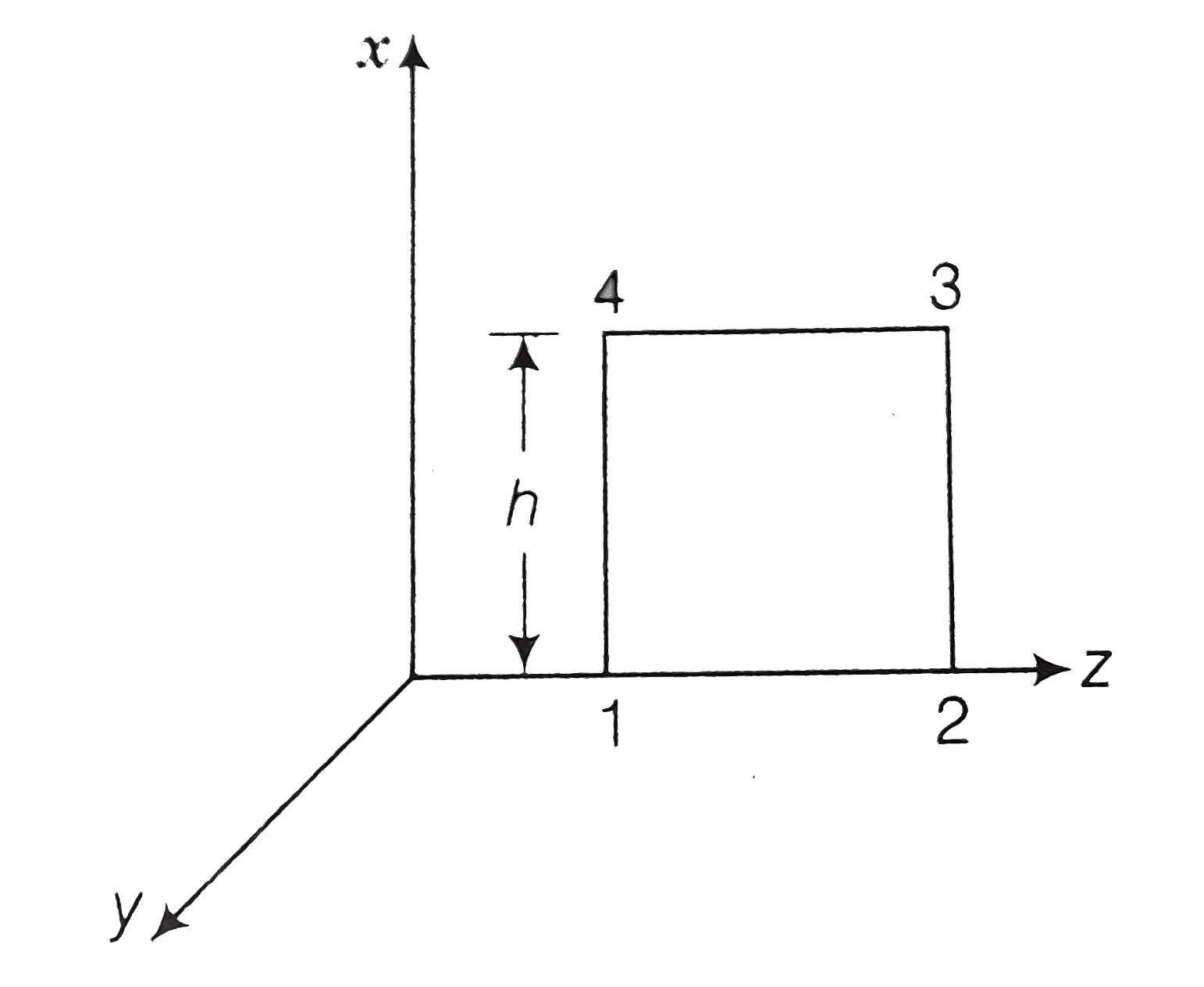The maxwell’s equation :
∮→B.→dl=μ0(i+ɛ0.dϕEdt) is a statement of -
Faraday’s law of induction
Modified Ampere’s law
Gauss’s law of electricity
Gauss’s law of magnetism
The correct Answer is:B
To solve the question regarding the Maxwell's equation given as:
∮→B⋅→dl=μ0(i+ε0dΦEdt)
we need to identify which of the four Maxwell's equations this represents.
1. Understand the Equation: The equation provided is an integral form of one of Maxwell's equations. It relates the magnetic field (→B) around a closed loop to the current (i) passing through that loop and the rate of change of electric flux (dΦEdt).
2. Identify the Components:
- The left side, ∮→B⋅→dl, represents the circulation of the magnetic field around a closed path.
- The right side consists of two terms: μ0i (the contribution from the current) and μ0ε0dΦEdt (the contribution from the changing electric field, known as displacement current).
3. Recall Maxwell's Equations: The four Maxwell's equations are:
- Gauss's Law for Electricity
- Gauss's Law for Magnetism
- Faraday's Law of Induction
- Ampère-Maxwell Law (which includes the displacement current term)
4. Match the Equation: The equation given matches the Ampère-Maxwell Law, which is a modification of Ampère's circuital law to include the displacement current. The original form of Ampère's law only considered current, while the modified form includes the term for the changing electric field.
5. Conclusion: Since the equation provided is the modified form of Ampère's law, we conclude that it represents the Ampère-Maxwell Law.
Final Answer:
The equation represents the Modified Ampère's Law (Option B).
---
- The left side, ∮→B⋅→dl, represents the circulation of the magnetic field around a closed path.
- The right side consists of two terms: μ0i (the contribution from the current) and μ0ε0dΦEdt (the contribution from the changing electric field, known as displacement current).
- Gauss's Law for Electricity
- Gauss's Law for Magnetism
- Faraday's Law of Induction
- Ampère-Maxwell Law (which includes the displacement current term)
The equation represents the Modified Ampère's Law (Option B).
Topper's Solved these Questions
- ELECTRO MAGNETIC WAVES BOOK - MOTIONCHAPTER - ELECTRO MAGNETIC WAVES EXERCISE - EXERCISE - 2
36 Videos
- ELECTRO MAGNETIC WAVES BOOK - MOTIONCHAPTER - ELECTRO MAGNETIC WAVES EXERCISE - EXERCISE - 3 (SECTION - A)
23 Videos
- ELECTRO MAGNETIC WAVES BOOK - MOTIONCHAPTER - ELECTRO MAGNETIC WAVES EXERCISE - EXERCISE - 3 (SECTION - B)
8 Videos
- ELECTRO MAGNETIC INDUCTIONBOOK - MOTIONCHAPTER - ELECTRO MAGNETIC INDUCTIONEXERCISE - EXERCISE-4| Section B (Prevous Years Problems )
29 Videos
- ELECTROMAGNETIC INDUCTIONBOOK - MOTIONCHAPTER - ELECTROMAGNETIC INDUCTIONEXERCISE - EXERCISE-4 (LEVEL-II)
13 Videos
Similar Questions
A plane EM wave travelling in vacuum along z-direction is given by E=E0 sin (kz−ωt)ˆi and B=B0 sin (kz−ωt)ˆj
(i) Evaluate ∫E.dl over the rectangular loop 1234 shown in figure.
(ii) Evaluate ∫B.ds over the surface bounded by loop 1234.
(iii) Use equation ∫E.dl=−dϕBdt to prove E0B0=c.
(iv) By using similar proces and the equation
∫B.dl=μ0I+ε0dϕEdt, prove that c1√μ0ε0

View SolutionA plane EM wave travelling in vacuum along z-direction is given by E=E0 sin (kz−ωt)ˆi and B=B0 sin (kz−ωt)ˆj
(i) Evaluate ∫E.dl over the rectangular loop 1234 shown in figure.
(ii) Evaluate ∫B.ds over the surface bounded by loop 1234.
(iii) Use equation ∫E.dl=−dϕBdt to prove E0B0=c.
(iv) By using similar proces and the equation
∫B.dl=μ0I+ε0dϕEdt, prove that c1√μ0ε0

View Solution
Knowledge Check
Maxwell's equation ∮→B⋅d→s=0 says
AMonopole can existBOnly dipole can existCMagnetic field lines are closed loopDNet flux through surface is zeroDimensions of ε0dϕEdt are same as that of
A[AT]B[A]C[ML2T−2]D[ML−1T−2]Maxwell’s equation ∮→E.→dl=d→B.→Adt is a statement of-
AAmpere’s lawBFaraday’s law of inductionCGauss’s law of electricityDGauss’s law of magnetism
Read the following passage and then answer questions (a) to (d) on the basis of your under- standing of the passage and the related studied concepts.
We are familiar with Ampere.s circuital law which states that for an open surface with a boundary around a current the line integral of magnetic field around the entire boundary of an open surface is equal to μ0 times the total current passing through the surface i.e.
∮→B.→dl=μ0I
Later on, Maxwell showed that for logical consistency, a changing electric field must also produce a magnetic field. In this context Maxwell introduced the concept of a displacement current given as per relation
ID=∈0dϕEdt
Thus, as per generalisation made by Maxwell, the source of a magnetic field is not just the conduction electric current due to following charges but also the time rate of change of electric field. In this way, Maxwell modified Ampere.s circuital law and in its modified the law is expressed as:
∮→B.→dl=μ0[IC+ID]=μ0[IC+∈0dϕEdt]
In all respects, the displacement current has the same physical effects as the conduction current. It is observed that in same cases, e.g., steady electric field in a wire, displacement current may be zero. In other cases, e.g., a capacitor being charged, both conduction and displacement currents may be present in different regions of space. In most of the cases, conduction current and displacement current may be present simultaneously in the same region of space because there exist no perfectly conducting or perfectly insulating medium. Moreover, there may be large regions of space where there is no conduction current but there is only a displacement current due to time varying electric field.
What did Maxwell suggest to make Ampere.s circuital law logical consistent?
View SolutionThe dimension of ε0dϕEdt is same as the dimension of
View SolutionDimensions of ε0dϕEdt are same as that of
View SolutionThe maxwells four equations are written as
i. ∮→E.−→dS=qε0
ii.∮→B.−→dS=0
iii. ∮→E.→dl=ddt∮→B.−→dS
iv. ∮→B.→dl=μ0εddt∮→E.−→dS
The equations which have sources of →E and →B are
View SolutionThe maxwells four equations are written as
(i) ∮→E.−→dS=q0ε0
(ii) ∮→B.−→dS=0
(iii) ∮→E.→dl=ddt∮→B.−→dS
(iv) ∮→B.→dl=μ0ε0ddt∮→E.−→dS
The equations which have sources of →E and →B are
View Solution
